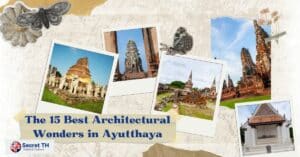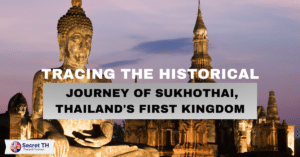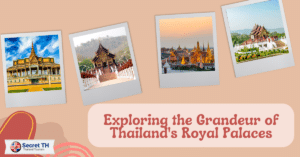The Sukhothai Historical Park is an archaeological site located in central Thailand. It features the remains of several temples and other structures that date back to the Khmer Empire. The park has been designated as a UNESCO World Heritage Site due to its unique architecture and its importance in Thai history.
This park is not just a mere collection of ancient structures; it is a testament to the grandeur of the Khmer Empire, showcasing the architectural marvels that have stood the test of time. In this blog post, we’ll embark on a journey through the nine major temples nestled within this UNESCO World Heritage Site, each echoing its individual story and significance in Thai history. Strap in for a journey back in time, as we unearth the secrets and marvels of the Sukhothai Historical Park.
Wat Mahathat
Wat Mahathat, located in the heart of Ayutthaya, Thailand, is a significant archaeological site. It whispers tales of the city’s grandeur in its heyday. The temple, known as the “Temple of the Great Relic,” is steeped in history and aesthetic allure. Notable for its vast, crumbling stone structures, it is best known for the iconic stone Buddha.
Its head is entwined within the roots of a Bodhi tree, a distinctive image that symbolizes the enduring spirituality amidst the ravages of time. The ruins of the temple have scattered Buddha statues and towering prangs (spires). This offers a poignant glimpse into Thailand’s rich religious and cultural past.
Address: 2P83+QF4, Mueang Kao, Mueang Sukhothai District, Sukhothai 64210, Thailand
For a virtual tour, click here.

Wat Si Sawai
Wat Si Sawai is a temple of great historical significance. It sits within the central zone of Sukhothai Historical Park, Thailand. Its three striking prangs (Khmer-style towers) set it apart from other temples in the area. The temple is believed to have been initially constructed as a Hindu sanctuary. It is dedicated to Shiva in the late 12th or early 13th century before Sukhothai became the capital.
The architectural style, displaying an intriguing blend of Hindu and Buddhist influences, reflects the unique cultural syncretism of the time. Beautiful stucco carvings depicting mythological creatures adorn the central prang. This adds to the temple’s mystique features. Wat Si Sawai serves as a compelling testament to the diverse religious traditions that have shaped Thailand’s cultural heritage.
Address: 2P72+FXP, Mueang Kao, Mueang Sukhothai District, Sukhothai 64210, Thailand
For pictures and more information, click here.

Wat Sa Si
Wat Sa Si is an enchanting Buddhist temple. It graces the serene island setting in the middle of Traphang-Trakuan Lake, Sukhothai Historical Park, Thailand. This picturesque temple is noted for its unique bell-shaped chedi (stupa) that rests on a lotus-shaped base. This a fine example of classic Sukhothai architecture. It’s also home to an impressive standing Buddha statue known as Phra Attharot.
It towers over the temple’s ancient remains. Dating back to the late 14th century, Wat Sa Si beautifully echoes the principles of Theravada Buddhism. They were prevalent in the Sukhothai era. Today, it remains a peaceful haven. Also, offer visitors a touch of tranquillity amidst the remnants of Thailand’s vibrant past.
Address: 2P92+VHV, Mueang Kao, Mueang Sukhothai District, Sukhothai 64210, Thailand
For more details and images, click here.

Wat Sorasak
Wat Sorasak, situated in Sukhothai Historical Park, Thailand, is a charming temple with unique architectural features that distinguish it from other temples within the park. Dating back to the 15th century, the temple is renowned for its bell-shaped chedi (stupa), encircled by a procession of sculpted elephants – a design element that bears testimony to the influence of Sri Lankan architecture on Sukhothai’s religious edifices.
The temple’s name is believed to have been derived from Prince Sorasak, a son of King Ramhamhaeng, who had reportedly built the temple. Today, Wat Sorasak stands as a symbol of Sukhothai’s illustrious past, capturing the imagination of visitors with its unique sculptural details and serene atmosphere.
Address: 2PF3+5VQ, Mueang Kao, Mueang Sukhothai District, Sukhothai 64210, Thailand

Wat Tra Phang Ngoen
Wat Tra Phang Ngoen, nestled within the Sukhothai Historical Park in Thailand, is a captivating temple that embodies the elegance of Sukhothai architecture. The name of the temple translates to “Silver Lake Temple,” a nod to its idyllic location near a serene pond. Its most distinguishing feature is a stunning lotus-bud chedi (stupa) that majestically towers above the temple complex, along with an ordination hall housing a seated Buddha image.
The temple, believed to have been built in the 14th century during the reign of King Li Thai, holds a significant spiritual and historical allure. Today, as the sun sets and reflects off the nearby pond, Wat Tra Phang Ngoen bathes in a tranquil glow, offering a mesmerizing sight that leaves an indelible mark on its visitors.
Address: 64210, Thailand, Sukhothai, Mueang Sukhothai District, Mueang Kao
For pictures and more information, click here.

Wat Si Chum
Wat Si Chum, located in the Sukhothai Historical Park, Thailand, is renowned for its colossal seated Buddha statue named “Phra Achana.” This monumental figure, reaching a height of 15 meters, is the largest in Sukhothai and dominates the open mandapa (pavilion) of the temple. The temple’s name translates to “Temple of the Bodhi Tree,” a reference to the sacred tree in Buddhist tradition under which Buddha achieved enlightenment.
Known for its unique architectural design, Wat Si Chum features a narrow passageway lined with murals, leading to the Buddha statue. These murals, though faded with time, depict Jataka tales, stories about the previous lives of the Buddha. Today, Wat Si Chum stands as an iconic symbol of Sukhothai’s glorious past, leaving visitors awestruck with its sheer size and spiritual aura.
Address: 2MGV+P7P, Mueang Kao, Mueang Sukhothai District, Sukhothai 64210, Thailand
Opening Hours: Monday – Sunday (6 AM – 5 PM)
For more details and images, click here.

Wat Phra Phai Luang
Wat Phra Phai Luang, a temple of considerable historical significance, is beautifully situated within the Sukhothai Historical Park, Thailand. This ancient temple predates the founding of the Sukhothai Kingdom. It stands as a silent testament to the shifts in religious and aesthetic trends over the centuries. It features a large Khmer-style prang (tower), indicative of its origins as a Hindu shrine.
Noteworthy are the large Buddha images adorning the walls of the main prang displaying a blend of Khmer and early Sukhothai styles. Also, the temple is surrounded by a moat, a typical feature of Khmer temples. Today, Wat Phra Phai Luang invites visitors to step back in time and explore the compelling narrative of Thailand’s cultural evolution.
Address: 2MHX+MQH, Mueang Kao, Mueang Sukhothai District, Sukhothai 64210, Thailand
Opening Hours: Monday – Sunday (6:30 AM – 5: 30 PM)
Phone: +66 55 697 527
For more details and a virtual tour, click here.

Wat Chetuphon
Wat Chetuphon, nestled within the Sukhothai Historical Park, Thailand, is an intriguing temple known for its collection of chedis (stupas). Each represents different styles from various eras of Thai history. The temple’s name translates to “Temple of the Seven Rows,” referring to the seven rows of chedis that stand in a symmetrical layout. Each chedi houses a Buddha image, displaying the artistic finesse and spiritual devotion of the Sukhothai Kingdom.
The diversity of architectural styles offers a visual narrative of evolving aesthetic sensibilities. Also, religious traditions over centuries. Today, Wat Chetuphon stands as a fascinating architectural gallery. It invites visitors to explore the nuanced history of Thailand’s sacred art and architecture.
Address: 56/2 ซอย สุโขทัยนคร 1 ซอย 4 Mueang Kao, Mueang Sukhothai District, Sukhothai 64210, Thailand
For more details and a virtual tour, click here.

Wat Saphan Hin
Wat Saphan Hin is perched atop a hill in the Sukhothai Historical Park, Thailand. It is a captivating site with historical and picturesque allure. The temple’s name translates to “Stone Bridge Temple,” derived from the slate pathway leading up to it. The ascent to the temple is a journey in itself, with panoramic views of the ancient city unfolding as one ascends. At the summit stands an impressive Standing Buddha statue.
This is known as Phra Attharot, which overlooks the city from a height of nearly 12.5 meters. Crafted in the distinctive Sukhothai style, this statue is a majestic sight to behold against the backdrop of the expansive skyline. Visiting Wat Saphan Hin requires a bit of a hike. But, the rewarding view and the serene ambiance make the climb worthwhile. The temple is a favorite among visitors for its tranquility and the awe-inspiring view it offers of the ancient city.
Address: 2MFG+6M9, Mueang Kao, Mueang Sukhothai District, Sukhothai 64210, Thailand

Conclusion
Sukhothai Historical Park, with its rich tapestry of temples, stands as a timeless testament to Thailand’s splendid cultural and spiritual heritage. Each temple, with its unique architectural charm and historical significance, narrates a piece of the grand saga of Thailand’s past. From the intriguing blend of Hindu and Buddhist influences at Wat Si Sawai. Even the towering Buddha statue at Wat Si Chum, the stunning panorama from Wat Saphan Hin.
The park offers a deep dive into the heart of Sukhothai’s glorious era. Amidst the tranquility and the remnants of the past. A visit to these temples is more than just a sightseeing tour. It’s a journey of historical discovery, architectural admiration, and spiritual reflection. This journey through the Sukhothai Historical Park is a captivating exploration of the echoes of time. It is etched in stone and shrouded in the spiritual aura of Thailand’s golden age.








